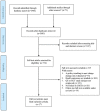The impact of user charges on health outcomes in low-income and middle-income countries: a systematic review
- PMID: 30792908
- PMCID: PMC6350744
- DOI: 10.1136/bmjgh-2018-001087
The impact of user charges on health outcomes in low-income and middle-income countries: a systematic review
Abstract
Background: User charges are widely used health financing mechanisms in many health systems in low-income and middle-income countries (LMICs) due to insufficient public health spending on health. This study systematically reviews the evidence on the relationship between user charges and health outcomes in LMICs, and explores underlying mechanisms of this relationship.
Methods: Published studies were identified via electronic medical, public health, health services and economics databases from 1990 to September 2017. We included studies that evaluated the impact of user charges on health in LMICs using randomised control trial (RCT) or quasi-experimental (QE) study designs. Study quality was assessed using Cochrane Risk of Bias and Risk of Bias in Non-Randomized Studies-of Intervention for RCT and QE studies, respectively.
Results: We identified 17 studies from 12 countries (five upper-middle income countries, five lower-middle income countries and two low-income countries) that met our selection criteria. The findings suggested a modest relationship between reduction in user charges and improvements in health outcomes, but this depended on health outcomes measured, the populations studied, study quality and policy settings. The relationship between reduced user charges and improved health outcomes was more evident in studies focusing on children and lower-income populations. Studies examining infectious disease-related outcomes, chronic disease management and nutritional outcomes were too few to draw meaningful conclusions. Improved access to healthcare as a result of reduction in out-of-pocket expenditure was identified as the possible causal pathway for improved health.
Conclusions: Reduced user charges were associated with improved health outcomes, particularly for lower-income groups and children in LMICs. Accelerating progress towards universal health coverage through prepayment mechanisms such as taxation and insurance can lead to improved health outcomes and reduced health inequalities in LMICs.
Trial registration number: CRD 42017054737.
Keywords: cost sharing; health systems financing; population health; user charges; user fees.
Conflict of interest statement
Competing interests: None declared
Figures


Similar articles
-
Folic acid supplementation and malaria susceptibility and severity among people taking antifolate antimalarial drugs in endemic areas.Cochrane Database Syst Rev. 2022 Feb 1;2(2022):CD014217. doi: 10.1002/14651858.CD014217. Cochrane Database Syst Rev. 2022. PMID: 36321557 Free PMC article.
-
Economic Burden of Chronic Ill Health and Injuries for Households in Low- and Middle-Income Countries.In: Jamison DT, Gelband H, Horton S, Jha P, Laxminarayan R, Mock CN, Nugent R, editors. Disease Control Priorities: Improving Health and Reducing Poverty. 3rd edition. Washington (DC): The International Bank for Reconstruction and Development / The World Bank; 2017 Nov 27. Chapter 6. In: Jamison DT, Gelband H, Horton S, Jha P, Laxminarayan R, Mock CN, Nugent R, editors. Disease Control Priorities: Improving Health and Reducing Poverty. 3rd edition. Washington (DC): The International Bank for Reconstruction and Development / The World Bank; 2017 Nov 27. Chapter 6. PMID: 30212160 Free Books & Documents. Review.
-
The impact of user fees on health service utilization in low- and middle-income countries: how strong is the evidence?Bull World Health Organ. 2008 Nov;86(11):839-848. doi: 10.2471/blt.07.049197. Bull World Health Organ. 2008. PMID: 19030689 Free PMC article. Review.
-
Universal Health Coverage and Essential Packages of Care.In: Jamison DT, Gelband H, Horton S, Jha P, Laxminarayan R, Mock CN, Nugent R, editors. Disease Control Priorities: Improving Health and Reducing Poverty. 3rd edition. Washington (DC): The International Bank for Reconstruction and Development / The World Bank; 2017 Nov 27. Chapter 3. In: Jamison DT, Gelband H, Horton S, Jha P, Laxminarayan R, Mock CN, Nugent R, editors. Disease Control Priorities: Improving Health and Reducing Poverty. 3rd edition. Washington (DC): The International Bank for Reconstruction and Development / The World Bank; 2017 Nov 27. Chapter 3. PMID: 30212154 Free Books & Documents. Review.
-
Effectiveness of road safety interventions: An evidence and gap map.Campbell Syst Rev. 2024 Jan 3;20(1):e1367. doi: 10.1002/cl2.1367. eCollection 2024 Mar. Campbell Syst Rev. 2024. PMID: 38188231 Free PMC article.
Cited by
-
National user fee abolition and health insurance scheme in Burkina Faso: How can they be integrated on the road to universal health coverage without increasing health inequities?J Glob Health. 2020 Jun;10(1):010319. doi: 10.7189/jogh.10.010319. J Glob Health. 2020. PMID: 32257144 Free PMC article. No abstract available.
-
Influence of Pharmaceutical Copayment on Emergency Hospital Admissions: A 1978-2018 Time Series Analysis in Spain.Int J Environ Res Public Health. 2021 Jul 29;18(15):8009. doi: 10.3390/ijerph18158009. Int J Environ Res Public Health. 2021. PMID: 34360302 Free PMC article.
-
Suggesting global insights to local challenges: expanding financing of rehabilitation services in low and middle-income countries.Front Rehabil Sci. 2024 Apr 22;5:1305033. doi: 10.3389/fresc.2024.1305033. eCollection 2024. Front Rehabil Sci. 2024. PMID: 38711833 Free PMC article.
-
Unlocking health equity by eliminating copayments for essential antihypertensive medications.EClinicalMedicine. 2025 Jan 30;81:103094. doi: 10.1016/j.eclinm.2025.103094. eCollection 2025 Mar. EClinicalMedicine. 2025. PMID: 39975701 Free PMC article. Review.
-
The effect of health financing systems on health system outcomes: A cross-country panel analysis.Health Econ. 2023 Mar;32(3):574-619. doi: 10.1002/hec.4635. Epub 2022 Dec 8. Health Econ. 2023. PMID: 36480236 Free PMC article.
References
-
- Le Blanc D. Towards integration at last? The sustainable development goals as a network of targets. Sustainable Development 2015;23:176–87. 10.1002/sd.1582 - DOI
Grants and funding
LinkOut - more resources
Full Text Sources
Miscellaneous
